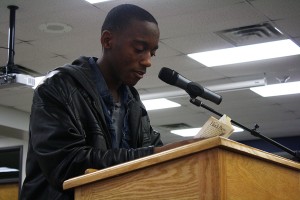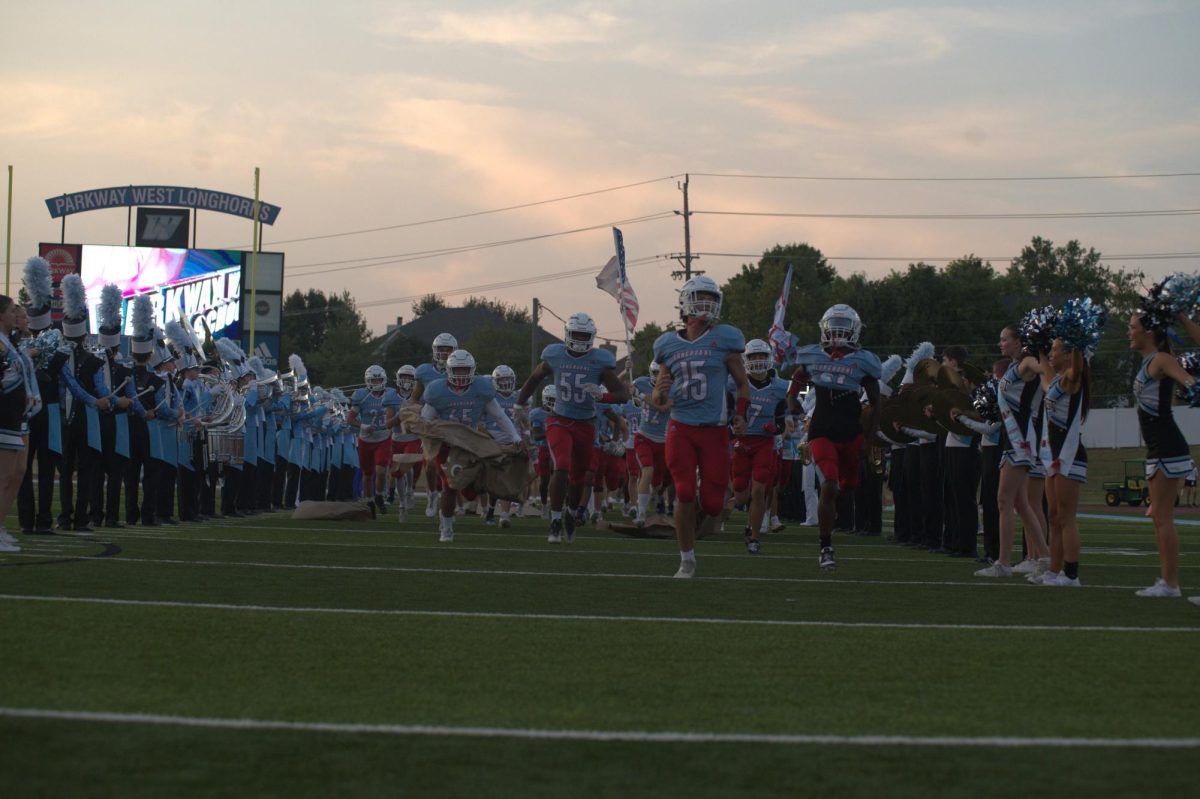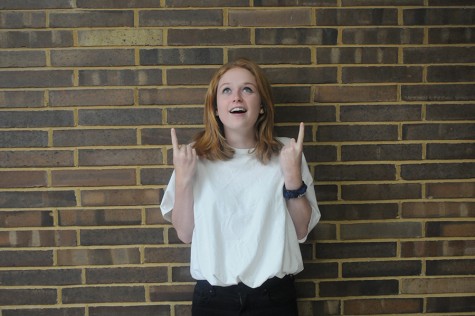To celebrate Black History Month, African American history trivia questions were asked over the announcements, a field trip was held to the GRIOT, the St. Louis Museum of Black History, on Feb. 25 and the 13th annual African American Read In was hosted on Feb. 26.
“No one should forget the hardships that our ancestors struggled through. I went to the library read in. I didn’t read anything but it was fun to watch; a lot of people read really good poems,” senior Brandon Deverse said.
Students read excerpts from various artists at the African American Read In in the library during both lunches.
“I read a little excerpt by a rapper, J. Cole. It’s called More Money. It was just about how money controls society nowadays and he was talking about how to controls black people too and how he just wished he had money. It’s really good,” senior Tashaun Ewing said.
The reading promotes reading and literacy according to Ewing.
“Sometimes people say [reading’s] a dying thing, that nobody reads anymore or reads poems or writes poems. So it’s just a way to get people together that have interests in poems and they can just have fun and jam out,” Ewing said.
The reading allowed students to show their styles and interests through poetry.
“If you like poetry or song lyrics that you just want to use as an artistic outlet but if you don’t have the patience for things like that than no it’s not for you. It’s cool to see people perform and choose specific poems so you can see their style and what they are really into so it’s nice,” Ewing said.

During the 13th annual African American Read-In in the West High library, junior Donte Hopkins reads “Love Your Enemy” by Yusef Iman. Pizza and dessert was served to all student present. “We all have to live together. In the past there was so much hatred. The poem is telling everyone not to forgive them for everything they have done, but instead love them. It represented how we have to keep moving forward and love each other no matter what happens,” Hopkins said.
Principal Jen Sebold, along with several other staff members, took a group of West High students to visit Griot, St. Louis’s Black History museum.
“There’s a lot of wax figures, and it goes through things like the slave trade, with actual documents from St. Louis blown up on the wall,” Sebold said. “It takes you through madam CJ Walker and her beauty products, and the value of hair in black culture. It has an entire room that has all kinds of information on figures who contributed to music and poetry, like Miles Davis and Josephine Baker.”
Junior Sydney Jackson attended the field trip and found the section of the museum on the slave trade particularly moving.
“We watched a video when we first got there called the Middle Passage, and it was basically about when the slaves were on a ship coming to America, and it really struck me how bad the conditions were; they were treated like animals,” Jackson said.
Jackson feels that all students could be impacted by this museum.
“I told Dr. Sebold that I think more people need to participate. They should take a different group that’s more diverse, because I feel like as African Americans, we already know a lot of this stuff because our family educates us on it, but a lot of other people don’t know how bad it was,” Jackson said. “It shouldn’t be forgotten.”
Through the field trip, Black History Month was commemorated, and Jackson thinks this is important.
“Black History Month can serve as a specific amount of time that we take out just to celebrate black culture and think about what we went through and what we overcame to make advancements in culture for everybody,” Jackson said.
Black History Month is important to acknowledge by caucasians as well as African Americans according to Sebold.
“I think listening to those voices that sometimes we want to shut down because white experiences and African American experiences are different, and we don’t have the same perspectives,” Sebold said. “I think the first step is listening and learning is the hardest step to overcome, because we want to hear, but we don’t want to listen. We need to listen and know that everyone has a story and everyone has a perspective, and everyone is valuable, and all of their perspectives and stories are as well.”


![Gazing up from the stage, junior Joseph McCurdy who played Peter Pan in the school play, Lost Girl, sits next to senior Juliana Rogers, who plays Wendy Darling, during a theater rehearsal. McCurdy’s passion for theater began when he observed a West High production in middle school. “I've been in the high school theater program since I was a freshman. I've always loved theater, but [what prompted me to join] was [when] I went to see [a performance here] when I was in middle school, and it was super cool,” McCurdy said.](https://pwestpathfinder.com/wp-content/uploads/2025/11/IMG_6535-1200x798.jpeg)

![Standing tall, stacked in a precise formation, the cheer team strikes a signature pose during halftime on Sept. 12 at the varsity football game. Nearly a month after this performance, the cheer team performed at the Missouri Cheerleading Coaches Association (MCCA) regional competition on Oct. 4, 2025. “We've all come [to] work together a lot more,” sophomore Elyssa Philippi said. “We're a lot closer than we were [earlier in the season] and going to state has made us closer [in] trying to work with each other, learn [new] skills and make our team better.”](https://pwestpathfinder.com/wp-content/uploads/2025/11/DSC5139-1.jpg)
![Handing out candy to excited trunk-or-treaters, President of the United Nations Children’s Fund club and junior Sara Ashok represents that group. Ashok was eager to participate in this event for multiple reasons. “I really wanted to be a part of the event because I get to help create memories for kids and spend time with my friends, spreading the things [I'm passionate about],” Ashok said.](https://pwestpathfinder.com/wp-content/uploads/2025/11/DSC_8648-1-1200x800.jpg)

![Smiling in a sea of Longhorns, Fox 2 reporter Ty Hawkins joins junior Darren Young during the morning Oct. 3 pep rally. The last time West was featured in this segment was 2011. “[I hope people see this and think] if you come to [Parkway] West, you will have the time of your life because there are so many fun activities to do that make it feel like you belong here. I was surprised so many people attended, but it was a lot of fun,” Young said.](https://pwestpathfinder.com/wp-content/uploads/2025/10/Edited2-1200x798.jpg)
![West High seniors and families listen as a representative of The Scholarship Foundation of St. Louis, Teresa Steinkamp, leads a Free Application for Federal Student Aid (FAFSA) workshop. This session, held in the library, provided guidance on financial aid, scholarships and student loan options. “This event is very beneficial for any seniors who are applying to or considering applying to colleges after high school [because] the cost of college is on the rise for seniors and parents,” college and career counselor Chris Lorenz said.](https://pwestpathfinder.com/wp-content/uploads/2025/09/DSC_4478-1200x778.jpg)
![Senior Kamori Berry walks across the field during halftime at the Homecoming football game on Sept. 12. During the pep assembly earlier that day, she was pronounced Homecoming Queen. “I thought it was nice that the crowd [started] cheering right away. I know [my friends] were really excited for me, and my family was happy because typically non-white people don't win,” Berry said.](https://pwestpathfinder.com/wp-content/uploads/2025/09/DSC7046-Enhanced-NR-1200x798.jpg)



![Sophomore Shree Sikkal Kumar serves the ball across the court in a match against Lindbergh. Sikkal Kumar has been a varsity member of the varsity girls’ tennis team for two years, helping her earn the number two rank in Class 2 District 2.“When matches are close, it’s easy to get nervous, but I [ground] myself by[staying] confident and ready to play,” Sikkal Kumar said.](https://pwestpathfinder.com/wp-content/uploads/2025/11/DSC2801-1200x798.jpg)
![Dressed up as the varsity girls’ tennis coach Katelyn Arenos, senior Kate Johnson and junior Mireya David hand out candy at West High’s annual trunk or treat event. This year, the trunk or treat was moved inside as a result of adverse weather. “As a senior, I care less about Halloween now. Teachers will bring their kids and families [to West’s Trunk or Treat], but there were fewer [this year] because they just thought it was canceled [due to the] rain. [With] Halloween, I think you care less the older you get,” Johnson said.](https://pwestpathfinder.com/wp-content/uploads/2025/10/DSC00892-1-1200x800.jpg)
![Focused on providing exceptional service, sophomore Darsh Mahapatra carefully cleans the door of a customer’s car. Mahapatra has always believed his customers deserve nothing less than the best. “[If] they’re trusting us with their car and our service, then I am convinced that they deserve our 100 percent effort and beyond,” Mahapatra said.](https://pwestpathfinder.com/wp-content/uploads/2025/10/DSC_0018-1200x800.jpg)
![Sophomore Aleix Pi de Cabanyes Navarro (left) finishes up a soccer game while junior Ava Muench (right) warms up for cross country practice. The two came to Parkway West High School as exchange students for the 2025-2026 school year. “The goal for the [exchange] program is to provide opportunities for both Parkway students and our international exchange students to learn about other cultures, build connections and become confident, capable, curious and caring — Parkway’s Four C’s — in the process,” Exchange Program Lead Lauren Farrelly said.](https://pwestpathfinder.com/wp-content/uploads/2025/10/Feature-Photo-1200x800.png)
![Leaning on the podium, superintendent Melissa Schneider speaks to Parkway journalism students during a press conference. Schneider joined Parkway in July after working in the Thompson School District in Colorado. “My plan [to bond with students] is to get things on my calendar as much as possible. For example, being in [classes] is very special to me. I am trying to be opportunistic [meeting] kids [and] being in [the school] buildings. I have all the sports schedules and the fine arts schedules on my calendar, so that when I'm available, I can get to them,” Schneider said.](https://pwestpathfinder.com/wp-content/uploads/2025/09/IMG_5425-1200x943.jpeg)
![Gazing across the stage, sophomore Alexis Monteleone performs in the school theater. The Monteleone family’s band “Monte and the Machine” has been releasing music since 2012, but Alexis started her own solo career in 2024 with the release of her first single, Crying Skies. “My whole family is very musical, [and I especially] love writing [songs with them],” Monteleone said.](https://pwestpathfinder.com/wp-content/uploads/2025/09/DSC7463-1200x798.jpg)
![Leaping through the air, senior Tyler Watts celebrates his first goal of the season, which put the Longhorns up 1-0 against the Lafayette Lancers. Watts decided to play soccer for West for his last year of high school and secured a spot on the varsity roster. “[Playing soccer for West] is something I had always dreamed of, but hadn’t really had a good opportunity to do until now. It’s [really] fun being out [on the field], and I’m glad I decided to join the team. It’s just all about having fun with the boys and enjoying what time we have left together,” Watts said.](https://pwestpathfinder.com/wp-content/uploads/2025/09/DSC_1951-1200x855.jpg)

![Shifting global trade, President Donald Trump’s tariffs are raising concerns about economic stability for the U.S. and other countries alike. “[The tariffs are] going to pose a distinct challenge to the U.S. economy and a challenge to the global economy on the whole because it's going to greatly upset who trades with who and where resources and products are going to come from,” social studies teacher Melvin Trotier said.](https://pwestpathfinder.com/wp-content/uploads/2025/05/MDB_3456-1200x800.jpg)
